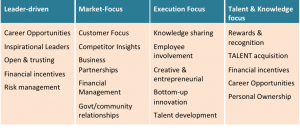We’ve always thought there must be a great success secret somewhere, and here it is in the form of a recipe! But how do you know you have the right formula? McKinsey’s latest research from more than 800 organisations globally might just reveal the answer.
New research by Mckinsey suggests that the performance payoff from organisational health is unexpectedly large. Companies have four distinct “recipes” to achieve it.
Performance-based organisational health is the capacity to deliver superior financial and operating performance – over the long term. Health is based on the ability to align around vision, strategy and culture; to execute with excellence; and to proactively renew focus in response to market trends.
Healthy companies generate performance (measured by shareholder return) three times higher than unhealthy ones, and over 60% higher than companies with “middle of the road” health profiles. This research shows that sustained organisational health is one of the most powerful assets a company can build.
Companies consistently outperforming their peers generally follow one of four “recipes.” But don’t try to cover everything. The secret is to identify your recipe, stamp out “broken” practices and build selected signature strengths.
The success recipe
All the healthiest organisations in McKinsey’s study had high health scores as measured by the nine outcomes of health. But four combinations of practices, or “recipes,” were associated with sustained success. Companies strongly aligned with any of these four recipes were five times more likely to be healthy and deliver strong, sustained performance than companies with mixed or random recipes.
Each of the four clusters reflects a distinct underlying approach to managing, including core beliefs about value creation and what drives organisational success. Each can be described by the specific set of management practices prioritized by companies that follow it.
The following table (headings revised) provides a snapshot of the four recipes.

1. Leader-driven
The hallmark of the first recipe is the presence at all levels of talented, high-potential leaders who are set free to figure out how to deliver results and are held accountable for doing so. Features are an open, trusting culture typical of highly decentralized organisations or new businesses. Career opportunities are used as a leadership-development practice. Role modeling and real experience are more important than passing along sage lessons.
2. Market-Focus
Organisations following the second recipe have an external orientation – to customers and competitors, business partners, regulators, and the community. They’re product innovators, building brands to stay ahead. The best both respond to demand and help shape it (eg Apple). A shared vision and strategic clarity ensures employees explore the right market opportunities. Strong financial management provides individual accountability.
3. Execution focus
This recipe is used by companies that stress continuous improvement, quality and productivity while eliminating waste and inefficiency. Knowledge is shared both to foster innovation and to drive standardization.
4. Talent & knowledge focus
The fourth recipe is found frequently among successful professional-services firms, professional sports teams, and entertainment businesses. They emphasize building competitive advantage by assembling and managing a high-quality talent and knowledge base. They have the right mix of financial and nonfinancial incentives to acquire the best talent and provide motivation and opportunity. They succeed thanks to highly skilled individual performers.
So – the success formula?
Take these general archetypes as inspiration and identify the pattern of healthy practices that best fits your organisation and strategies. But don’t just blindly seek to replicate one of the cluster recipes practice by practice. Consider the following issues.
Align strategy and health
Successful companies match their organisations to their aspirations. Identify the most appropriate organisational recipe for the chosen strategy. Then align the organisation as far as possible with a relevant mix of practices. Day-to-day practice must support the strategy, or it will undermine performance and health.
The importance of selection
The trick is to be truly great in a handful of practices. In practices that are not essential to a company’s recipe, you only have to be better than bottom.
73% of the companies that strongly or very strongly follow one of the four recipes, and are not in the bottom quartile for any practice, enjoy top-quartile health.
But only 7% of companies that have at least one broken practice and a less-than-strong embrace of any of the recipes are in the top quartile. Taken together, this represents a better than 10:1 ratio of effectiveness.
So fix all broken practices (to escape the bottom) and turn a targeted handful of practices into true strengths. Trying to exceed benchmark on many practices is not effective.
Avoid recipe killers
You wouldn’t bake a beautiful chocolate soufflé then destroy it by adding too much salt. Likewise, adding the wrong practices to your organisational recipe can be extremely harmful.
One example McKinsey provide is overemphasising command-and-control leadership styles when trying to follow the execution recipe. Execution requires tremendous on-the-ground energy, so the best execution-driven organisations use internal competition and bottom-up innovation to empower the front line to excel. Overuse of top-down processes kills the dynamic – the least healthy execution-edge organisations are those that have the authoritative-leadership practice in their top ten.
Summary
Building organisational health can be a powerful lever for improving the long-term performance of companies.
Choose your recipes and ingredients carefully, as the wrong mix may leave a bad taste in the mouths of employees, executives, and investors alike.
Get it right, and you’ve got it made.
A more extensive description of this revealing research is here.

